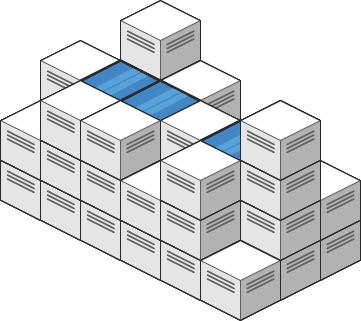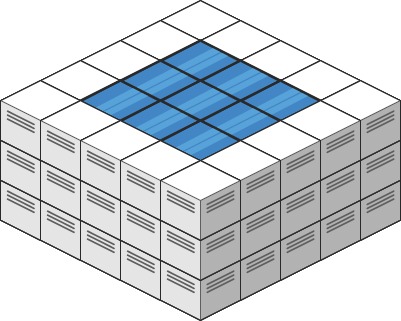原文链接: https://leetcode-cn.com/problems/trapping-rain-water-ii
英文原文
Given an m x n integer matrix heightMap representing the height of each unit cell in a 2D elevation map, return the volume of water it can trap after raining.
Example 1:

Input: heightMap = [[1,4,3,1,3,2],[3,2,1,3,2,4],[2,3,3,2,3,1]] Output: 4 Explanation: After the rain, water is trapped between the blocks. We have two small ponds 1 and 3 units trapped. The total volume of water trapped is 4.
Example 2:

Input: heightMap = [[3,3,3,3,3],[3,2,2,2,3],[3,2,1,2,3],[3,2,2,2,3],[3,3,3,3,3]] Output: 10
Constraints:
m == heightMap.lengthn == heightMap[i].length1 <= m, n <= 2000 <= heightMap[i][j] <= 2 * 104
中文题目
给你一个 m x n 的矩阵,其中的值均为非负整数,代表二维高度图每个单元的高度,请计算图中形状最多能接多少体积的雨水。
示例 1:

输入: heightMap = [[1,4,3,1,3,2],[3,2,1,3,2,4],[2,3,3,2,3,1]] 输出: 4 解释: 下雨后,雨水将会被上图蓝色的方块中。总的接雨水量为1+2+1=4。
示例 2:

输入: heightMap = [[3,3,3,3,3],[3,2,2,2,3],[3,2,1,2,3],[3,2,2,2,3],[3,3,3,3,3]] 输出: 10
提示:
m == heightMap.lengthn == heightMap[i].length1 <= m, n <= 2000 <= heightMap[i][j] <= 2 * 104
通过代码
高赞题解
解题思路
前言:可能不是最好的思路,如果有好的思路麻烦大佬们艾特我学习下!谢谢了!
接雨水I中,我们维护了左右两个最高的墙,那么在这里,就是维护周围一个圈,用堆来维护周围这一圈中的最小元素。为什么是维护最小的元素不是最大的元素呢,因为木桶原理呀。这个最小的元素从堆里弹出来,和它四个方向的元素去比较大小,看能不能往里灌水,怎么灌水呢,如果用方向就比较复杂了,我们可以用visited数组来表示哪些遍历过,哪些没遍历过。如果当前弹出来的高度比它周围的大,他就能往矮的里面灌水了,灌水后要把下一个柱子放进去的时候,放的高度要取两者较大的,也就是灌水后的高度,不是它原来矮的时候的高度了,如果不能灌水,继续走。
Given the following 3x6 height map:
[
[1,4,3,1,3,2],
[3,2,1,3,2,4],
[2,3,3,2,3,1]
]就拿这个例子来说,我们先把第一圈都放进去,然后开始从堆中弹出,第一圈,最小值是1(遍历时候标记为访问过),1从堆里弹出来,比如弹出来1(坐标[0,3]),它下方的3没有被访问过,尝试灌水,发现不能灌水,3入堆,然后继续弹。比如说,我此时弹出来一个3(坐标[1,0]),它能向右边2(坐标[1,1])灌水,那这边就可以统计了,然后我们要插入2(坐标[1,1])这个位置,但是插入的时候,要记得你得是插入的高度得是灌水后的高度,而不是原来的高度了
当然我这边只是举个例子哈
代码
class Solution {
public int trapRainWater(int[][] heights) {
if (heights == null || heights.length == 0) return 0;
int n = heights.length;
int m = heights[0].length;
// 用一个vis数组来标记这个位置有没有被访问过
boolean[][] vis = new boolean[n][m];
// 优先队列中存放三元组 [x,y,h] 坐标和高度
PriorityQueue<int[]> pq = new PriorityQueue<>((o1, o2) -> o1[2] - o2[2]);
// 先把最外一圈放进去
for (int i = 0; i < n; i++) {
for (int j = 0; j < m; j++) {
if (i == 0 || i == n - 1 || j == 0 || j == m - 1) {
pq.offer(new int[]{i, j, heights[i][j]});
vis[i][j] = true;
}
}
}
int res = 0;
// 方向数组,把dx和dy压缩成一维来做
int[] dirs = {-1, 0, 1, 0, -1};
while (!pq.isEmpty()) {
int[] poll = pq.poll();
// 看一下周围四个方向,没访问过的话能不能往里灌水
for (int k = 0; k < 4; k++) {
int nx = poll[0] + dirs[k];
int ny = poll[1] + dirs[k + 1];
// 如果位置合法且没访问过
if (nx >= 0 && nx < n && ny >= 0 && ny < m && !vis[nx][ny]) {
// 如果外围这一圈中最小的比当前这个还高,那就说明能往里面灌水啊
if (poll[2] > heights[nx][ny]) {
res += poll[2] - heights[nx][ny];
}
// 如果灌水高度得是你灌水后的高度了,如果没灌水也要取高的
pq.offer(new int[]{nx, ny, Math.max(heights[nx][ny], poll[2])});
vis[nx][ny] = true;
}
}
}
return res;
}
}统计信息
| 通过次数 | 提交次数 | AC比率 |
|---|---|---|
| 25014 | 43169 | 57.9% |
提交历史
| 提交时间 | 提交结果 | 执行时间 | 内存消耗 | 语言 |
|---|
相似题目
| 题目 | 难度 |
|---|---|
| 接雨水 | 困难 |



